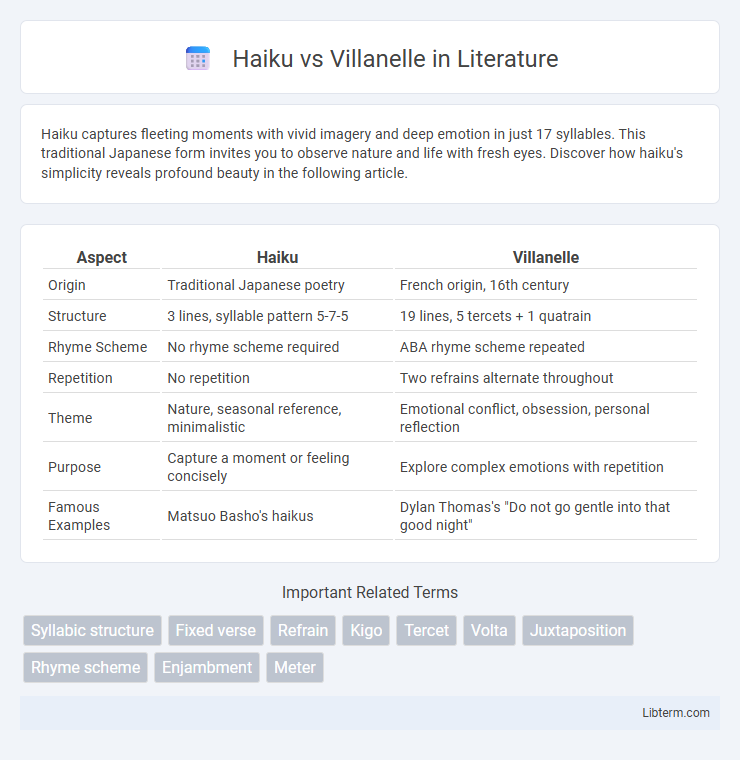Haiku captures fleeting moments with vivid imagery and deep emotion in just 17 syllables. This traditional Japanese form invites you to observe nature and life with fresh eyes. Discover how haiku's simplicity reveals profound beauty in the following article.
Table of Comparison
| Aspect | Haiku | Villanelle |
|---|---|---|
| Origin | Traditional Japanese poetry | French origin, 16th century |
| Structure | 3 lines, syllable pattern 5-7-5 | 19 lines, 5 tercets + 1 quatrain |
| Rhyme Scheme | No rhyme scheme required | ABA rhyme scheme repeated |
| Repetition | No repetition | Two refrains alternate throughout |
| Theme | Nature, seasonal reference, minimalistic | Emotional conflict, obsession, personal reflection |
| Purpose | Capture a moment or feeling concisely | Explore complex emotions with repetition |
| Famous Examples | Matsuo Basho's haikus | Dylan Thomas's "Do not go gentle into that good night" |
Introduction to Haiku and Villanelle
Haiku is a traditional Japanese poetic form consisting of three lines with a 5-7-5 syllable pattern, emphasizing nature, simplicity, and seasonal themes. Villanelle is a complex 19-line French poetic form structured with five tercets and a final quatrain, featuring two refrains and a strict rhyme scheme (ABA). Both forms challenge poets to convey deep emotions and vivid imagery within distinct structural constraints.
Historical Origins of Haiku
Haiku traces its historical origins to 17th-century Japan, evolving from the earlier linked-verse poetry known as renga. This poetic form traditionally consists of 17 syllables arranged in a 5-7-5 pattern and emphasizes seasonal themes and simplicity. In contrast, the villanelle originates from 16th-century France as a fixed-form poem with repeating lines and a strict rhyme scheme, highlighting its European Renaissance roots.
Historical Background of the Villanelle
The villanelle originated in the late 16th century as a French poetic form characterized by its strict pattern of nineteen lines with five tercets and a quatrain, featuring two repeating rhymes and refrains. Its roots trace back to rustic songs and dance forms from the Provence region, evolving into a highly structured and lyrical form through poets like Jean Passerat. The villanelle gained renewed popularity in the 20th century, with poets such as Dylan Thomas and Elizabeth Bishop bringing modern recognition to this traditional form.
Structural Differences: Haiku vs Villanelle
Haiku consists of three lines with a strict syllable pattern of 5-7-5, emphasizing brevity and nature themes. Villanelle features 19 lines divided into five tercets and a final quatrain, incorporating two repeating refrains and a specific rhyme scheme (ABA). The structural complexity of the villanelle contrasts sharply with the haiku's minimalist form, shaping distinct rhythmic and thematic expressions.
Thematic Focus and Subject Matter
Haikus emphasize nature, seasons, and fleeting moments, capturing simplicity and sensory experiences in just 17 syllables across three lines. Villanelles explore complex emotions, obsession, and recurring thoughts through 19 lines with refrains and a strict rhyme scheme, allowing for thematic depth and repetition. While Haikus evoke brevity and immediacy, Villanelles delve into cyclical patterns and emotional intensity.
Language Style and Imagery
Haikus utilize concise, minimalist language with a syllabic pattern of 5-7-5, emphasizing nature imagery and moments of subtle insight. Villanelles employ a structured rhyme scheme and repeated refrains, creating a lyrical, cyclical effect that often conveys intense emotions or themes. The imagery in villanelles tends to be more elaborate and symbolic, contrasting with the Haiku's simplicity and immediacy.
Famous Haiku Poems and Poets
Haiku, a traditional Japanese form consisting of three lines with a 5-7-5 syllable structure, emphasizes nature and seasonal themes, with Matsuo Basho regarded as one of the most famous haiku poets whose works like "An old silent pond" are celebrated worldwide. Villanelles are 19-line poetic forms with a strict pattern of repetition and rhyme, exemplified by Dylan Thomas's "Do not go gentle into that good night," though their complexity contrasts with haiku's minimalist style. Haiku's brevity and vivid imagery have influenced poets globally, making it a cornerstone of modern minimalist poetry.
Notable Villanelles and Their Authors
Notable villanelles include "Do not go gentle into that good night" by Dylan Thomas, a powerful exploration of defiance against death through repeating refrains. Another prominent example is "One Art" by Elizabeth Bishop, which uses the villanelle form to poignantly examine loss and the art of losing. These villanelles demonstrate the form's unique ability to combine strict repetition with emotional intensity.
Creative Challenges and Writing Tips
Haiku demands precision and brevity, typically adhering to a 5-7-5 syllable structure that captures vivid imagery and seasonal themes; writers should focus on simplicity and sensory details to evoke emotion within limited words. Villanelle involves a complex 19-line form with two repeating rhymes and refrains, challenging poets to balance repetition and variation; mastering the interwoven refrains enhances thematic depth and musicality. Emphasizing strict structural discipline in Haiku and inventive manipulation of repetition in Villanelle helps overcome creative barriers and refine poetic expression.
Choosing Between Haiku and Villanelle
Choosing between a Haiku and a Villanelle depends on the desired structure and thematic depth; Haikus capture moments in three lines with a 5-7-5 syllable pattern, emphasizing brevity and nature imagery, while Villanelles consist of 19 lines with a strict rhyme and repetition scheme, ideal for exploring complex emotions and themes. Haikus excel in simplicity and immediacy, making them perfect for concise reflections, whereas Villanelles demand careful attention to form and allow for lyrical repetition to intensify mood. Writers seeking minimalism and focus often prefer Haikus, while those aiming for emotional resonance and elaborate expression gravitate toward Villanelles.
Haiku Infographic

 libterm.com
libterm.com